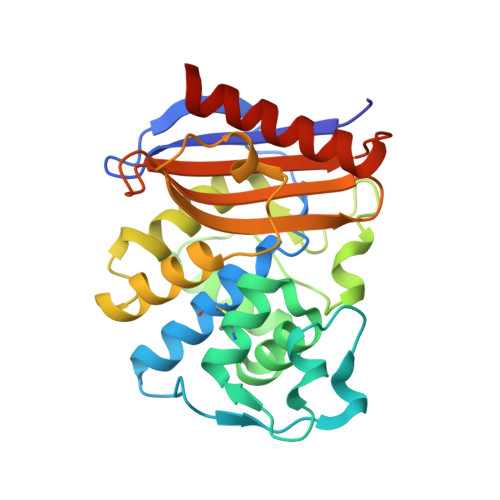Exploring the Molecular Linkage of Protein Stability Traits for Enzyme Optimization by Iterative Truncation and Evolution.
Speck, J., Hecky, J., Tam, H.K., Arndt, K.M., Einsle, O., Muller, K.M.(2012) Biochemistry 51: 4850-4867
- PubMed: 22545913
- DOI: https://doi.org/10.1021/bi2018738
- Primary Citation of Related Structures:
3TOI - PubMed Abstract:
The stability of proteins is paramount for their therapeutic and industrial use and, thus, is a major task for protein engineering. Several types of chemical and physical stabilities are desired, and discussion revolves around whether each stability trait needs to be addressed separately and how specific and compatible stabilizing mutations act. We demonstrate a stepwise perturbation-compensation strategy, which identifies mutations rescuing the activity of a truncated TEM β-lactamase. Analyses relating structural stress with the external stresses of heat, denaturants, and proteases reveal our second-site suppressors as general stability centers that also improve the full-length enzyme. A library of lactamase variants truncated by 15 N-terminal and three C-terminal residues (Bla-NΔ15CΔ3) was subjected to activity selection and DNA shuffling. The resulting clone with the best in vivo performance harbored eight mutations, surpassed the full-length wild-type protein by 5.3 °C in T(m), displayed significantly higher catalytic activity at elevated temperatures, and showed delayed guanidine-induced denaturation. The crystal structure of this mutant was determined and provided insights into its stability determinants. Stepwise reconstitution of the N- and C-termini increased its thermal, denaturant, and proteolytic resistance successively, leading to a full-length enzyme with a T(m) increased by 15.3 °C and a half-denaturation concentration shifted from 0.53 to 1.75 M guanidinium relative to that of the wild type. These improvements demonstrate that iterative truncation-optimization cycles can exploit stability-trait linkages in proteins and are exceptionally suited for the creation of progressively stabilized variants and/or downsized proteins without the need for detailed structural or mechanistic information.
Organizational Affiliation:
Institute for Biochemistry and Biology, University of Potsdam, Potsdam, Germany.














